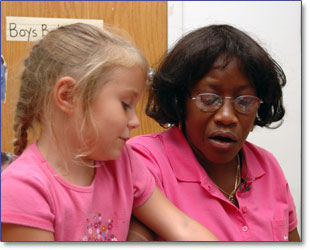  (Page 2 of 3) (Page 2 of 3)
Grammar
When we use
words and sentences to communicate, we follow rules
that govern how we put words together. These rules
make up the syntax or
grammar of our language. Children learn to apply
these rules instinctively long before they formally
know what the rules are.
Children demonstrate their increasing use of
complex phrases and sentences in the ways they
combine words. A toddler reaches out and says,
“Milk!” while months later, the same
child says, “Want milk.” Still later,
he might say, “I want milk,” a
complete sentence. Eventually, his combination
of words becomes more precise and the grammar
becomes more complex when he asks a question, “May
I please have some milk?”
Children learn most of what they know about English grammar before they reach kindergarten. They learn during the first few years of life, through listening to others communicate and through their own attempts at communication, what grammatical structures work in our language and which ones don’t work. They develop a sense of what “sounds right” and what doesn’t.
Children acquire this sense of grammar best when
they experience many models of language, used
well, and when they have many opportunities to
talk with more mature users of the language. Young
children need many opportunities to talk with
adults who will listen attentively and expand
on what they say. It is through these experiences
that children grow in their use of language. The
more children talk, the more they understand language,
and the better they get at using language.

Speaking
As children grow, they learn more
about how to pronounce words so they can be understood
by others. We’ve all heard young children’s
attempts to say words. Sometimes those attempts
are very close approximations of the word, and
sometimes the child’s pronunciation makes
the word very difficult to understand. Sometimes,
only a parent can understand what the child
is saying. To be understood by others, a child
must learn to produce sounds in words that are
closer to the way others produce those same
sounds. When they can do this, this shows they
are learning to attend to the sounds in language.
If children are embarrassed and disturbed by
their speech, or if their language skills seem
to be well behind that of their peers, discuss
your concerns with supervisors or other appropriate
persons.
In addition to learning to speak more clearly,
prekindergarten children are expanding their conversational
skills. It is important for children to learn
how to initiate and participate in conversations,
how to take turns speaking in different settings,
and how to listen and respond to communication.
Specific instructional strategies and environmental
considerations are included in this training to
help you learn more about how to improve children’s
speaking, listening, and conversational skills.
|